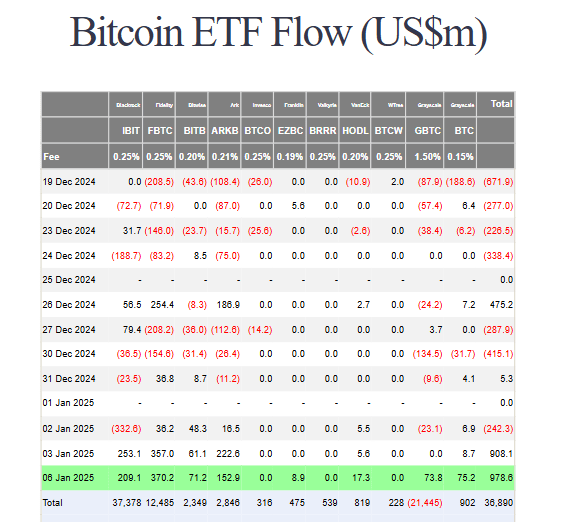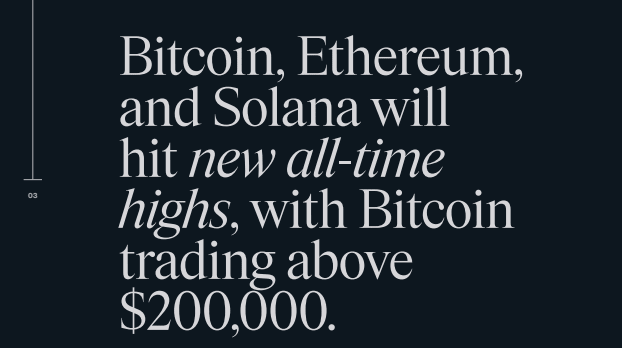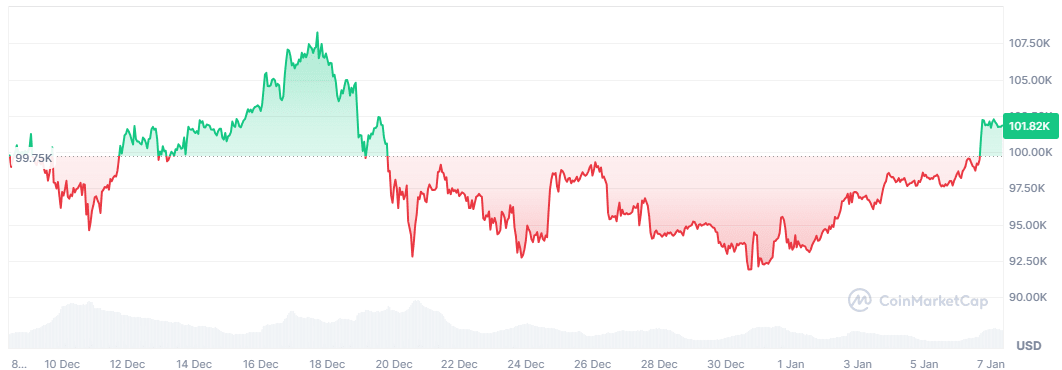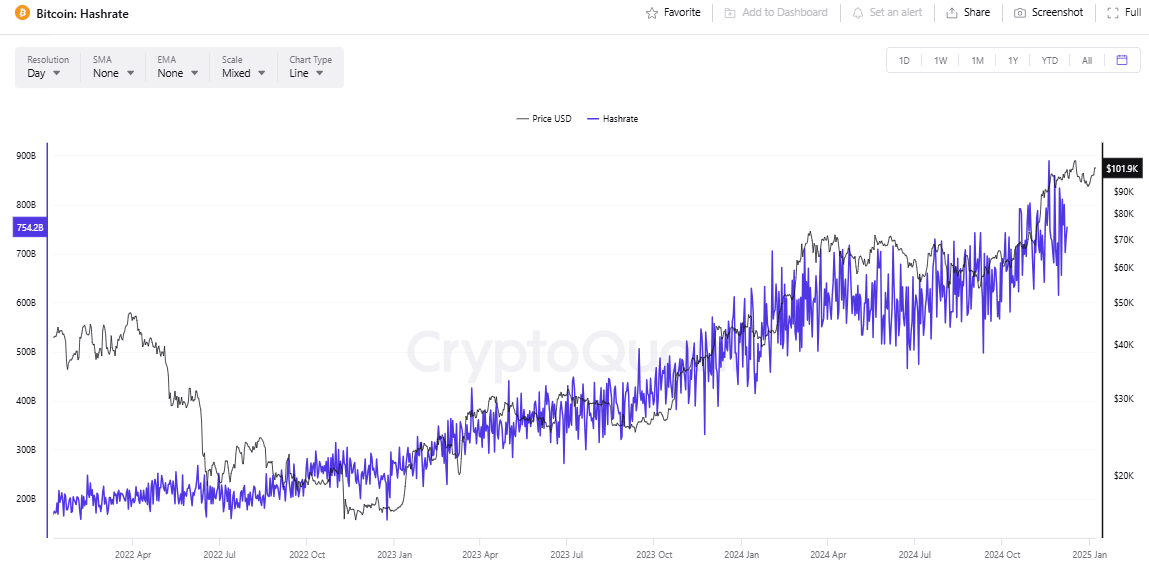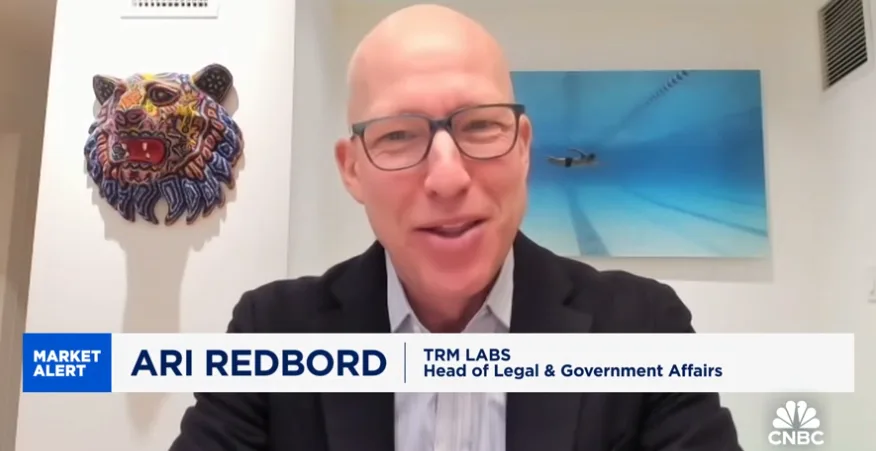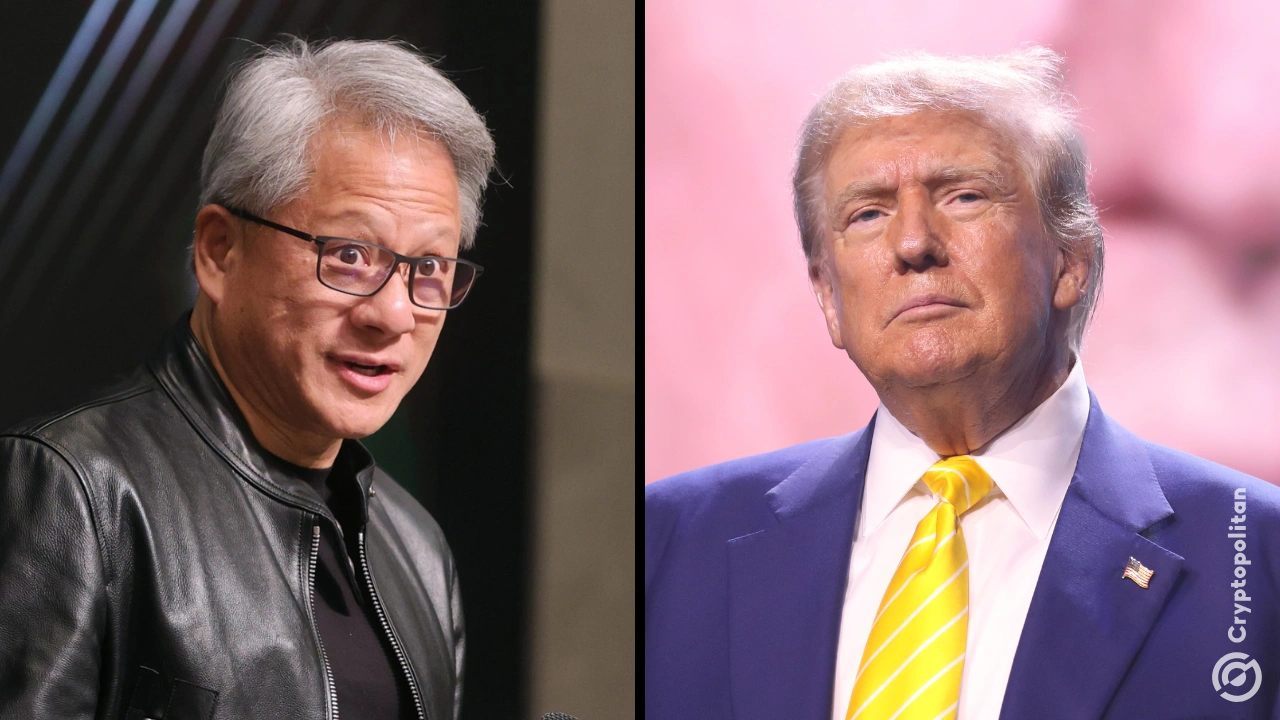This demand outpaced Bitcoin miner supply, which created a supply-demand imbalance. The Bitcoin network also achieved impressive milestones over the past year, like processing $19 trillion in transactions in 2024 and recently reaching an all-time high hashrate of 1,000 EH/s. Political shifts in the United States, including pro-crypto appointments in key federal roles, boosted optimism for Bitcoin and broader crypto adoption.
Bitcoin ETFs End Outflow Streak
United States-based spot Bitcoin exchange-traded funds (ETFs) experienced a surge in demand after recording close to $1.9 billion in net inflows on Jan. 3 and Jan. 6. This was a reversal of the sluggish activity that was seen during the latter half of December.
On Jan. 6 alone, Bitcoin ETFs attracted $978.6 million in investments, with the Fidelity Wise Origin Bitcoin Fund leading the pack with $370.2 million. BlackRock’s iShares Bitcoin ETF and ARK 21Shares Bitcoin ETF followed with $209 million and $153 million, respectively, according to data from Farside Investors.
Bitcoin ETF flow (Source: Farside Investors)
Other ETFs, including Bitwise’s Bitcoin ETF and Grayscale’s GBTC, also saw good inflows. Meanwhile, the VanEck Bitcoin ETF and Franklin Bitcoin ETF reported inflows of $17.3 million and $8.9 million, respectively. However, ETFs from Invesco, Valkyrie, and WisdomTree recorded no inflows on the same day.
The robust inflows during these two strong trading days almost offset the $1.9 billion in net outflows that happened between Dec. 19 and Jan. 2. Since their launch nearly a year ago, spot Bitcoin ETFs accumulated a total of $36.9 billion in net inflows. Among these, BlackRock’s iShares Bitcoin ETF leads the market with $37.4 billion in inflows, while the Fidelity Wise Origin Bitcoin Fund amassed $12.4 billion. In contrast, Grayscale’s GBTC struggled quite a bit to keep up, and saw $21.4 billion in outflows.
While retail investors account for the majority of demand, a Binance report from October 2024 pointed out that analysts expect greater institutional participation in the coming years. Bitwise’s Chief Investment Officer Matt Hougan expects this shift to gain a lot of momentum in 2025, driven by the introduction of additional clearinghouses for spot Bitcoin ETF trading. This could turn Bitwise’s bullish projection of Bitcoin reaching $200,000 by 2025 into a reality.
(Source: Bitwise)
Bitcoin ETFs Outpace Miner Supply
Despite the outflows at the end of the month, December 2024 is still considered to be a great month for spot Bitcoin ETFs in the US as they accumulated approximately 51,500 BTC. This was almost three times the 13,850 coins that were produced by miners during the month, according to data from Apollo and BiTBO.
This caused a big imbalance in the supply-demand dynamic, with Bitcoin demand from ETFs outpacing miner production by 272%. The momentum in spot markets also propelled Bitcoin to an all-time high of around $108,135 on Dec. 17.
BTC’s price action over the past month (Source: CoinMarketCap)
Jesse Myers, co-founder of Onramp Bitcoin, also pointed out the strain on supply, and stated that the available Bitcoin at current prices could not meet the soaring demand. This surge in market activity happened after the election of Donald Trump as president in November, which catalyzed increased interest in Bitcoin. Crypto researcher Vivek also warned of an imminent supply shock as exchange balances hit new lows. The start of 2025 continued this strong trend with impressive inflows into the ETFs.
Meanwhile, major Bitcoin mining firms released their production figures for December. MARA Holdings led the pack with 9,457 BTC, which far surpassed other miners. Riot reported a 4% production increase by mining 516 BTC, while Cleanspark produced 668 BTC. Core Scientific mined 291 BTC from its own fleet, Bitfarms added 211 BTC, Terawulf earned 158 self-mined coins, and BitFuFu reported producing 111 BTC. Despite these outputs, miner production was still insufficient to counterbalance the surging demand from Bitcoin ETFs.
Bitcoin Transactions Surged to $19 Trillion in 2024
In 2024, the Bitcoin network processed more than $19 trillion in transactions, more than doubling the $8.7 trillion that was settled in 2023 and reversing two years of declining transaction volumes. This was also a major rebound from the 2021 bull market peak of $47 trillion, which saw sharp declines in the subsequent years.
Pierre Rochard, vice president of research at Riot Platforms, pointed to the achievement as evidence that Bitcoin serves both as a store of value and a medium of exchange. The year was pivotal for Bitcoin thanks to the launch of a US-based Bitcoin ETFs, the April halving event, and a new all-time price high.
The start of 2025 also brought more milestones, with the Bitcoin network’s hashrate reaching a record 1,000 exahashes per second (EH/s) on Jan. 3, before stabilizing at around 775 EH/s. The hashrate measures the total computing power securing the network, and reflects Bitcoin’s growing adoption and infrastructure investment. U.S.-based mining pools accounted for over 40% of the global hashrate in 2024. Foundry USA and MARA Pool were responsible for 38.5% of all blocks mined.
Bitcoin network hashrate (Source: CryptoQuant)
It is important to keep in mind that determining precise hashrate dominance is still a bit challenging because of the decentralized and pseudonymous nature of Bitcoin mining. Mining pool operators may be headquartered in one country while receiving contributions from individual miners globally. Additionally, tools like virtual private networks (VPNs) obscure the geographical locations of miners, which only adds to the complexity of hashrate analysis.
Crypto Boom the New “Space Race”
Even after the successful 2024 for Bitcoin and crypto in general, there is still room for even more excitement. Recent pro-crypto political appointments in the United States caused a lot of excitement and optimism in the digital asset industry. These feelings were even compared to a “space race” that could position the country as a global leader in cryptocurrency adoption and innovation.
Ari Redbord, head of legal and government affairs at TRM Labs, mentioned this sentiment during an interview on CNBC’s Squawk Box on Jan. 6. He stated that the United States now has the perfect opportunity to surpass other nations in embracing digital assets.
(Source: CNBC)
Redbord attributed this positive momentum to key appointments in federal agencies since Donald Trump’s presidential election victory. Some of the appointments include hedge fund manager Scott Bessent as Treasury secretary, Paul Atkins as Securities and Exchange Commission chair, and venture capitalist David Sacks, who was called the White House’s “crypto czar.” According to Redbord, these appointments prove the incoming administration’s strong commitment to digital assets, innovation, and AI at the highest levels of government.
Redbord is especially excited about the developments in the crypto space beyond Bitcoin. He pointed to the adoption of stablecoins by fintech companies like Stripe and Cash App, which are using the technology at scale for payments. He also noticed a shift in the perception of Bitcoin from being solely a store of value to a technology that enables cross-border payments, remittances, and everyday transactions.
When asked for a Bitcoin price prediction, Redbord declined to provide a specific figure but suggested the asset’s value could go “significantly higher.” He mentioned incentives like a potential strategic Bitcoin reserve in the United States and similar moves by other countries as factors that could drive demand.
This optimism aligns with the views of other market analysts like Daan Crypto Trades, who said on Jan. 7 that Bitcoin is just beginning its price discovery phase.







